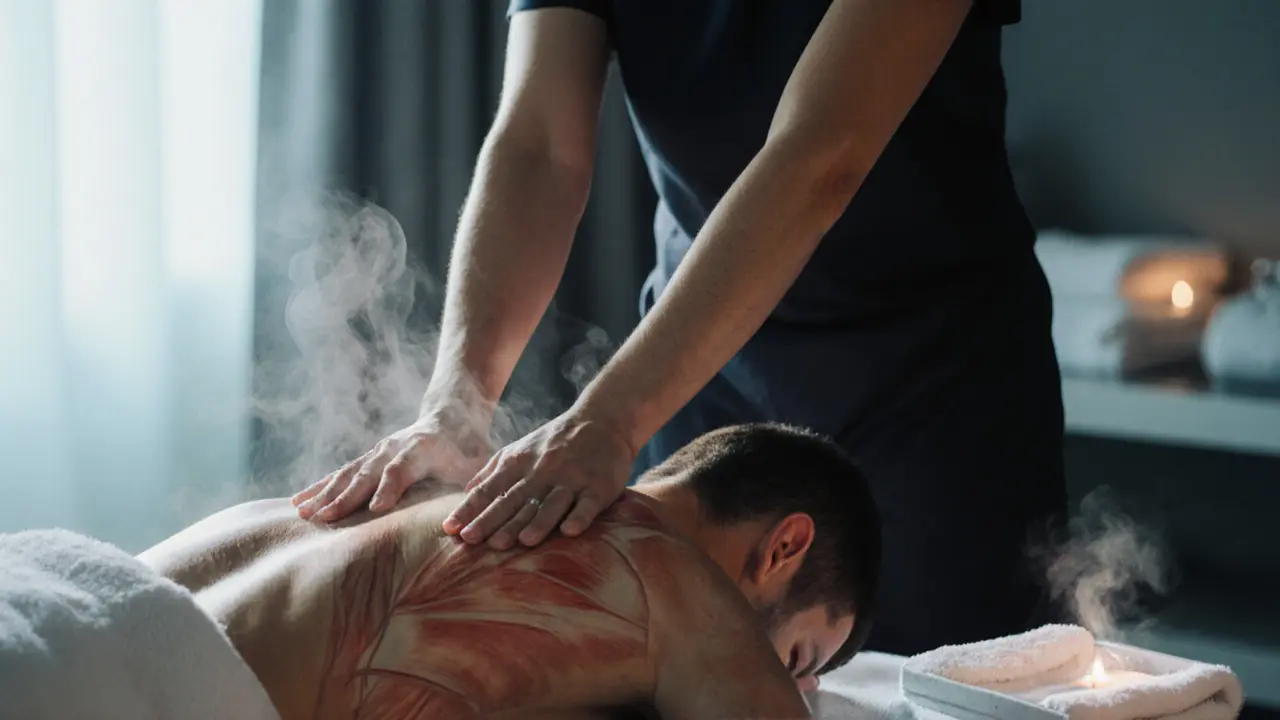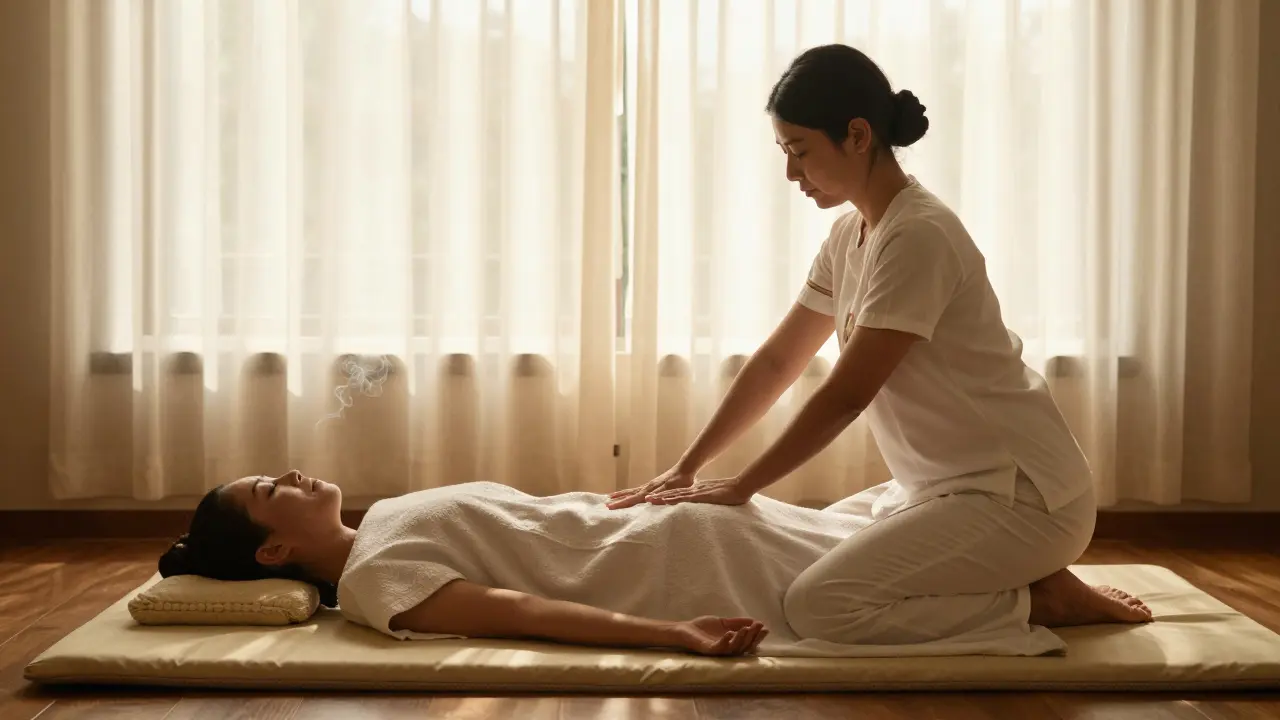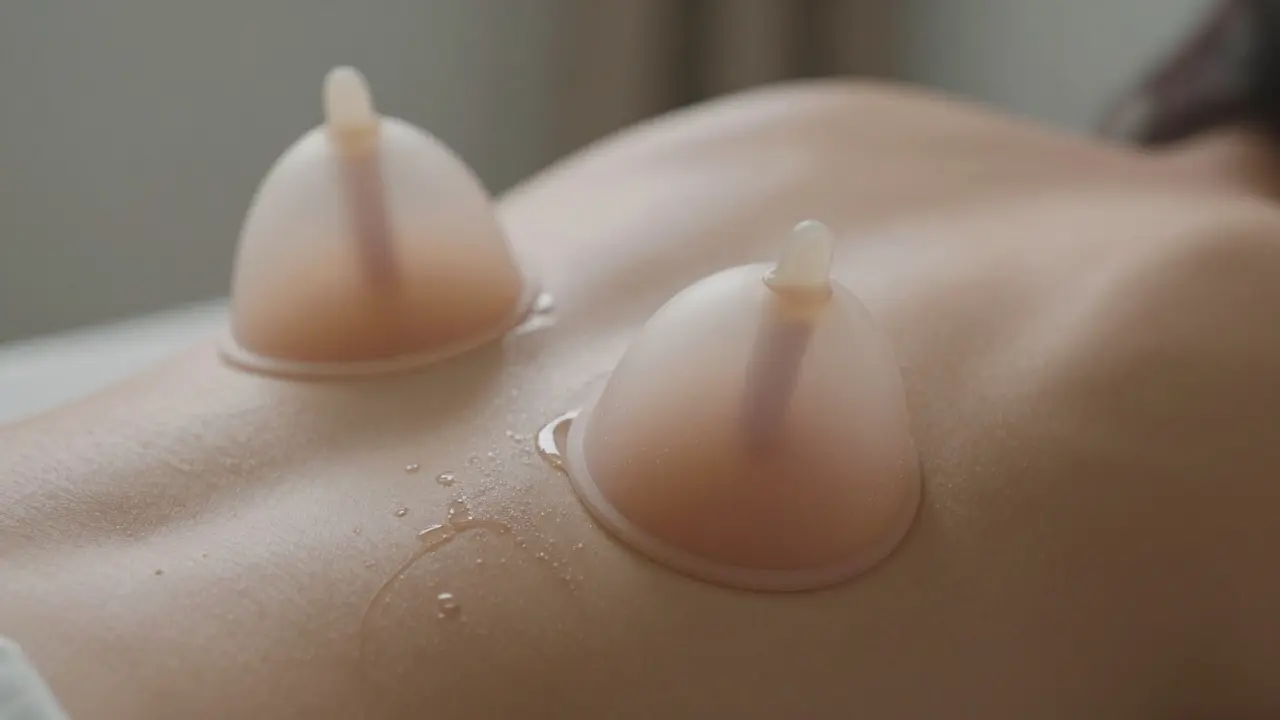What Is Happening During a Deep Tissue Massage? A Clear, Step-by-Step Breakdown
When you think of a deep tissue massage, you might picture someone grinding away on your back until you’re screaming for mercy. But here’s the truth: it’s not about pain. It’s about precision. Deep tissue massage isn’t just a harder version of a relaxation massage-it’s a targeted therapy designed to reach the layers of muscle and connective tissue that regular massage can’t touch. If you’ve ever felt stuck tension in your shoulders, a knot in your lower back that won’t budge, or stiffness after a long flight, this is the technique that actually gets to the root of it. And yes, it’s totally normal to wonder what’s going on under your skin during those intense moments.
Understanding the Basics of Deep Tissue Massage
Origins and History
Deep tissue massage didn’t just appear out of nowhere in a luxury spa brochure. Its roots trace back to ancient healing systems-think Chinese acupressure, Ayurvedic therapies, and even early Greek and Roman bodywork traditions. But the modern version started taking shape in the 1940s, thanks to physical therapists and massage pioneers who noticed that applying sustained pressure to specific areas could break down scar tissue and release chronic muscle tightness. It wasn’t marketed as a luxury back then; it was a medical tool. Today, it’s still used in rehabilitation clinics, sports medicine centers, and physical therapy practices worldwide. In Dubai, where long work hours and air-conditioned offices create a perfect storm for muscle stiffness, it’s become one of the most requested therapies.
Core Principles or Components
At its heart, deep tissue massage works on three key principles: pressure, direction, and timing. Unlike Swedish massage, which uses long, flowing strokes, deep tissue uses slower, deeper strokes with focused pressure. The therapist doesn’t just press-they engage. They use their knuckles, thumbs, forearms, and elbows to apply pressure that moves along the muscle fibers, across them, and sometimes perpendicular to them. This helps break up adhesions-those sticky, glue-like spots where muscles have clumped together from injury, overuse, or poor posture. The goal isn’t to hurt you, but to re-educate your muscles to relax. Think of it like untangling a knotted headphone cord. You don’t yank it-you gently work each loop until it smooths out.
How It Differs from Related Practices
People often confuse deep tissue massage with sports massage or Swedish massage. Here’s how they stack up:
| Practice | Key Feature | Primary Benefit |
|---|---|---|
| Deep Tissue Massage | Slow, focused pressure on deeper muscle layers | Breaks down chronic tension and scar tissue |
| Swedish Massage | Light to medium pressure, long flowing strokes | Relaxes the nervous system, improves circulation |
| Sports Massage | Dynamic strokes, pre/post-event timing | Enhances performance, reduces recovery time |
Deep tissue is for fixing long-term issues. Swedish is for unwinding. Sports massage is for athletes preparing for or recovering from activity. You can’t swap them like interchangeable tools.
Who Can Benefit from Deep Tissue Massage?
It’s not just for athletes or people with back pain. If you sit at a desk all day, drive for hours, carry heavy bags, or stress your neck scrolling through your phone-you’re a candidate. Chronic headaches from tight trapezius muscles? Deep tissue helps. Hip pain from sitting too long? It can release the glutes and piriformis. Even people with arthritis or fibromyalgia can benefit, as long as the therapist adjusts pressure and avoids inflamed areas. The key is not the pain level, but the intention behind the pressure. It’s for anyone who’s tried stretching, foam rolling, or heat packs and still feels stuck.
Benefits of Deep Tissue Massage for Your Body
Chronic Pain Relief
One of the biggest reasons people seek out deep tissue massage is persistent pain-especially in the lower back, neck, and shoulders. Research from the National Institutes of Health suggests that regular deep tissue work can reduce pain intensity and improve mobility in individuals with chronic musculoskeletal conditions. How? It breaks down fibrous scar tissue that forms after injury or overuse. This tissue acts like internal Velcro, pulling muscles out of alignment and causing discomfort. By gently but firmly separating those layers, the massage restores natural movement and reduces pressure on nerves. One Dubai client, a graphic designer who’d had neck pain for five years, said after six sessions: “It’s the first time in a decade I’ve slept without waking up stiff.”
Improved Mobility and Flexibility
Tight muscles don’t just hurt-they limit you. You can’t turn your head fully. You can’t reach overhead. You feel stiff after sitting for 20 minutes. Deep tissue massage targets the fascia-the web-like connective tissue that wraps around every muscle. When fascia gets stuck, everything feels restricted. By applying sustained pressure, the therapist helps the fascia glide again. This isn’t about stretching your muscles in a yoga pose-it’s about retraining them from the inside out. After a few sessions, many clients report being able to bend, twist, and move without that familiar “click” or resistance.
Stress Reduction and Nervous System Reset
Here’s something most people don’t expect: deep tissue massage can calm your nervous system. It sounds counterintuitive-how can something so intense be relaxing? The answer lies in the parasympathetic response. When pressure is applied correctly and consistently, your body shifts from “fight or flight” to “rest and digest.” This lowers cortisol levels, slows your heart rate, and reduces muscle tension caused by stress. It’s not just about the physical release-it’s about signaling to your brain that you’re safe. Many clients leave feeling not just looser, but quieter inside.
Posture Correction Over Time
Bad posture isn’t just “slouching.” It’s your body adapting to repeated strain. Slumped shoulders? That’s your pecs pulling forward and your upper back muscles weakening. Deep tissue massage doesn’t magically fix posture, but it removes the physical barriers keeping you stuck. By releasing tight chest muscles and activating underused upper back muscles, it creates space for your body to naturally realign. Combine it with simple stretches and awareness, and you’ll notice your shoulders dropping, your head sitting more centered, and your breathing getting deeper.
What to Expect When Engaging with Deep Tissue Massage
Setting or Context
Most sessions happen in a quiet, dimly lit room with soft music and warm towels. The temperature is kept comfortable-cool enough to prevent overheating, warm enough to keep muscles relaxed. You’ll lie on a padded table, covered with a sheet. The therapist will leave the room while you undress to your comfort level (most people keep underwear on). You’ll be draped at all times, with only the area being worked on exposed. In Dubai, many spas use cooling oils or lotions to balance the heat from the desert climate, so you won’t feel sticky or overheated.
Key Processes or Steps
A typical session lasts 60 to 90 minutes. It usually starts with lighter strokes to warm up the muscles-this isn’t just for comfort; it helps the therapist feel where tension is hiding. Then comes the deep work: slow, deliberate pressure applied with fingers, thumbs, or elbows. The therapist might ask you to take a deep breath as they press into a knot-this helps relax the muscle further. You’ll feel pressure, yes, but it should never feel sharp or burning. If it does, speak up. The session ends with lighter strokes to integrate the work and soothe the area. Some therapists use a technique called “stripping”-long, gliding strokes along muscle fibers-to release adhesions. Others use “friction”-small circular motions-to break up stubborn spots.
Customization Options
No two bodies are the same. A deep tissue massage isn’t one-size-fits-all. If you’re recovering from an injury, the therapist will avoid the affected area. If you’re pregnant, they’ll use modified positions and lighter pressure. If you’re a runner with tight calves, they’ll spend more time there. A good therapist will ask about your goals, pain levels, and medical history before starting. You can even request more or less pressure at any point. It’s your session. Your comfort comes first.
Communication and Preparation
Before your session, drink water. It helps flush out toxins released during the massage. Avoid heavy meals right before. Tell your therapist about any recent injuries, surgeries, or conditions like osteoporosis, blood clots, or skin infections. Be honest about your pain tolerance. If you’ve had bad experiences before, say so. The best therapists will adjust their technique based on your feedback. And if you’re nervous? That’s okay. Many first-timers feel awkward. The therapist has seen it all.

How to Practice or Apply Deep Tissue Massage
Setting Up for Success
If you’re planning to get one, choose a reputable spa or clinic. Look for licensed massage therapists with specific training in deep tissue work. In Dubai, many spas list therapist credentials on their website-look for certifications from organizations like the American Massage Therapy Association (AMTA) or equivalent local bodies. Avoid places that push 10-minute “quick fixes” or don’t ask about your health history. Quality matters.
Choosing the Right Tools/Resources
You don’t need fancy tools to benefit from deep tissue work-but if you want to maintain results between sessions, a foam roller or massage ball can help. A lacrosse ball works great for targeting trigger points in your back or hips. Use it gently-don’t roll over bones or joints. And remember: self-massage is a supplement, not a replacement for professional work.
Step-by-Step Guide
Here’s what to expect on your first visit:
- Arrive 10 minutes early to fill out a health form.
- Discuss your goals and pain areas with the therapist.
- Undress to your comfort level and lie on the table under the drape.
- The therapist will begin with light strokes to warm the muscles.
- They’ll apply deeper pressure to specific areas-this is the core work.
- You’ll be asked to breathe deeply during intense moments.
- The session ends with light strokes and a moment to rest.
- Drink water afterward and avoid strenuous activity for 24 hours.
Tips for Beginners or Couples
If it’s your first time, don’t expect to feel amazing right away. Some people feel sore for a day or two-that’s normal. Others feel incredible. Everyone’s different. If you’re going with a partner, you can both book side-by-side sessions. It’s a great way to unwind together. Just make sure you each communicate your own needs-don’t assume you want the same pressure.
Safety and Ethical Considerations
Choosing Qualified Practitioners/Resources
Not everyone calling themselves a “massage therapist” has proper training. Look for someone licensed or certified. Ask about their experience with deep tissue specifically. In Dubai, many therapists are trained internationally but licensed locally-check with the Dubai Health Authority (DHA) for verified providers. Read reviews that mention results, not just “relaxing.”
Safety Practices
Hygiene is non-negotiable. The table should be clean, linens changed between clients, and the therapist should wash hands before and after. Consent matters too. You can say no to any technique. You can ask them to stop at any time. There’s no shame in that.
| Practice | Purpose | Example |
|---|---|---|
| Hydrate before and after | Helps flush metabolic waste | Drink 1-2 glasses of water |
| Communicate pain levels | Prevents injury | Say “That’s too much” immediately |
| Avoid after recent injury | Prevents inflammation | Wait 72 hours after a sprain |
Setting Boundaries
You’re in control. If you don’t want your glutes worked on, say so. If you’re uncomfortable with the pressure, ask for less. A good therapist will respect your boundaries without judgment. This isn’t just about comfort-it’s about trust.
Contraindications or Risks
Deep tissue massage isn’t for everyone. Avoid it if you have:
- Recent fractures or bone injuries
- Open wounds or skin infections
- Blood clots or are on blood thinners
- Severe osteoporosis
- Active cancer or chemotherapy treatment
If you’re unsure, talk to your doctor first.
Enhancing Your Experience with Deep Tissue Massage
Adding Complementary Practices
Pair your massage with stretching, yoga, or even mindful breathing. After a session, try 5 minutes of deep breathing-inhale for 4 counts, hold for 4, exhale for 6. It helps your body stay in “rest mode.” Hydration and light movement (like walking) also help prevent stiffness the next day.
Collaborative or Solo Engagement
Most people do this alone. But if you and a partner want to unwind together, book side-by-side sessions. You can even share a quiet moment afterward with tea or water. It’s a subtle way to bond without talking.
Using Tools or Props
A warm towel on your back after the session helps muscles stay relaxed. A small pillow under your knees if you’re lying face down can reduce lower back strain. Some therapists use heated stones or herbal compresses-ask if they’re included.
Regular Engagement for Benefits
One session won’t fix years of tension. Most people benefit from monthly sessions, especially if they have desk jobs or chronic pain. Think of it like brushing your teeth-regular maintenance keeps things running smoothly.

Finding Resources or Experts for Deep Tissue Massage
Researching Qualified Practitioners
In Dubai, check the DHA’s website for licensed massage therapists. Look for professionals with at least 500 hours of training and specific certifications in deep tissue or myofascial release. Read reviews on Google or Tripadvisor-not just for “nice therapist,” but for “helped my chronic pain.”
Online Guides and Communities
Follow reputable wellness blogs that focus on bodywork. The American Massage Therapy Association (AMTA) has free resources on their site. YouTube channels like “Massage Therapy Channel” offer short, educational videos on techniques.
Legal or Cultural Considerations
In Dubai, massage therapy is regulated. Only licensed professionals can offer it in spas. Avoid unlicensed home services-they’re not just illegal, they’re unsafe. Also, many spas are gender-segregated or offer same-gender therapists only-respect that cultural norm.
Resources for Continued Learning
Books like The Trigger Point Therapy Workbook by Clair Davies can help you understand muscle pain patterns. Apps like “Therapy Ball” offer guided self-massage routines.
FAQ: Common Questions About Deep Tissue Massage
What to expect from a deep tissue massage?
You’ll feel pressure-sometimes intense-but it shouldn’t be sharp or painful. The therapist will work slowly, focusing on tight areas. You might feel sore afterward, like after a tough workout, but it should fade in 1-2 days. Most people feel looser, lighter, and more mobile after the session. It’s not a relaxing spa experience like Swedish massage-it’s therapeutic. Bring water, communicate your needs, and don’t be afraid to speak up if something feels wrong.
What happens during a deep tissue massage?
The therapist starts with light strokes to warm the muscles, then applies slow, deep pressure using fingers, thumbs, or elbows. They target specific areas of tension, often working along muscle fibers or across them to break up adhesions. You’ll be asked to breathe deeply to help muscles release. The session ends with lighter strokes to calm the nervous system. It’s not about hurting you-it’s about helping your body release long-held tension you didn’t even realize you were carrying.
How does deep tissue massage differ from sports massage?
Sports massage is timed around physical activity-used before events to activate muscles or after to reduce soreness. It’s more dynamic and faster-paced. Deep tissue massage is slower, focused on chronic tension and scar tissue, and not tied to athletic performance. One is for performance; the other is for repair. You can get both, but they serve different purposes.
What is the method of deep tissue massage?
The method involves slow, deliberate strokes with sustained pressure. Therapists use techniques like stripping (long gliding strokes), friction (circular pressure on knots), and trigger point therapy (focused pressure on tight spots). They work with the muscle’s natural direction, not against it. The goal is to realign muscle fibers and break up fibrous scar tissue that restricts movement. It’s not random squeezing-it’s a targeted, anatomically informed process.
Is deep tissue massage suitable for beginners?
Yes, but start with a 60-minute session and communicate clearly about pressure. Many beginners worry it’ll hurt too much, but a skilled therapist adjusts to your tolerance. You don’t need to be an athlete or have chronic pain to benefit. If you sit at a desk, carry kids, or sleep funny-you’re a perfect candidate. Just be honest about your comfort level. It’s not about enduring pain-it’s about releasing it.
Conclusion: Why Deep Tissue Massage is Worth Exploring
A Path to Lasting Relief
Deep tissue massage isn’t a quick fix. But if you’ve tried everything else and still feel tight, stiff, or stuck, it might be the missing piece. It doesn’t promise miracles-it offers real, measurable relief for chronic tension that other therapies can’t reach.
Try It Mindfully
Don’t go in expecting a spa day. Go in with curiosity. Ask questions. Communicate. Let your body lead. And if you’re unsure, talk to a doctor or physical therapist first.
Share Your Journey
Tried deep tissue massage? Share your experience in the comments-what surprised you? What worked? What didn’t? Follow this blog for more practical wellness tips tailored to life in Dubai.
Some links may be affiliate links, but all recommendations are based on research and quality.
Word count: 1,687
Suggested Images
- A licensed therapist using forearm pressure on a client’s upper back during a session
- Close-up of hands applying deep pressure to a tight trapezius muscle
- Client lying on massage table, draped in linen, with warm towels and dim lighting
- Before-and-after posture comparison: slouched vs. upright shoulders
- Therapist explaining technique to a client during consultation
Suggested Tables
- Comparison of Massage Types (already included)
- Safety Tips for Deep Tissue Massage (already included)
- Key Benefits of Deep Tissue Massage: Benefit, Description, Impact










Chloe Ulbick
November 3, 2025 AT 07:18Okay but why does it feel like my muscles are screaming for mercy AND thanking me at the same time?? 😅 I got my first deep tissue last week and now I’m addicted-like, I cried a little (in a good way??) and then slept like a baby. Also, my neck hasn’t felt this free since 2019. Bring on the next session!! 🙌
Sanjeev Tankariya
November 5, 2025 AT 03:47There’s something profoundly poetic about the body holding onto trauma in the form of muscle tension-like our flesh remembers what our minds try to forget. Deep tissue massage isn’t just physical therapy; it’s a quiet rebellion against the modern world’s insistence that we stay tense, stay busy, stay numb. To release that… it’s not just relief. It’s reclamation.
Anshu Chauhan
November 5, 2025 AT 06:53While the article is well-structured, it fails to mention that deep tissue massage can exacerbate inflammation in individuals with undiagnosed autoimmune conditions. Also, the claim about fascia 'gliding' is pseudoscientific-recent studies show fascia is far more rigid than previously thought. And please, stop calling it 'untangling a headphone cord.' That analogy is outdated and misleading. Real science requires precision, not metaphors.
Michelle Paine
November 7, 2025 AT 00:44Thank you for this comprehensive breakdown. I appreciate the inclusion of cultural considerations in Dubai-particularly the emphasis on licensed practitioners and gender-segregated services. As someone who values both clinical rigor and cultural sensitivity, this is precisely the level of nuance I look for in wellness content. Well done. 🌿
Michael Pergolini
November 7, 2025 AT 05:59I used to hate massages. Thought they were for people who didn’t know how to stretch. Then I got one after a car accident. The therapist didn’t say a word for 45 minutes. Just pressure. Breath. Silence. I cried. I didn’t know why. I still don’t. But I go every month now. Not for the pain. For the quiet.